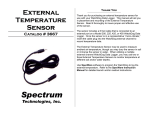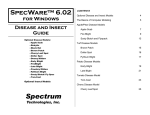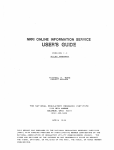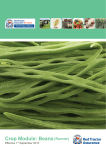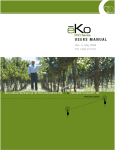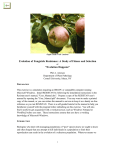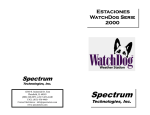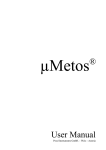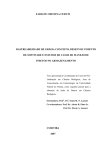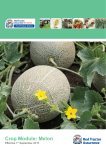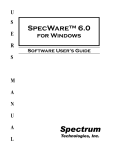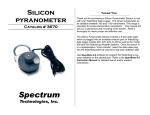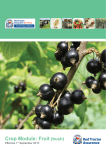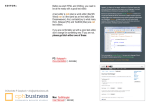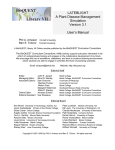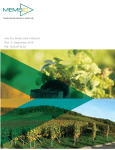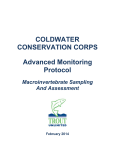Download the page - Spectrum Technologies
Transcript
SpecWare 9 Pro Software DISEASE AND INSECT GUIDE Item #’s 3656GA, 3656AP, 3656TU, 3656PO, 3656TO, 3656CH Optional Disease Models: • Apple Scab • Botrytis • Black Rot • Brown Patch • Cherry Leaf Spot • Dollar Spot • Downy Mildew • Early Blight • FireBlight • Late Blight • Phomopsis Cane Leaf Spot • Powdery Mildew • Pythium Blight • Sooty Blotch/Flyspeck • Tom-Cast Optional Insect Models 2 CONTENTS Optional Disease and Insect Models 4 The Basics of Computer Modeling 5 Apple/Pear Disease Models Apple Scab 7 Fire Blight 9 Sooty Blotch and Flyspeck 13 Turf Disease Models Brown Patch 15 Dollar Spot 16 Pythium Blight 17 Potato Disease Models Early Blight 19 Late Blight 21 Tomato Disease Model Tom-Cast 23 Cherry Disease Model Cherry Leaf Spot 25 3 Grape Disease Models Black Rot 27 Downy Mildew 29 Powdery Mildew 31 Phomopsis Cane and Leaf Spot 33 Botrytis 34 Disease Model References 35 Insect Models 37 Insect Model References 41 Software License Agreement 44 4 Optional Disease and Insect Models SpecWare software includes models to predict infection events for the following diseases and for insects. These models are provided FREE for a 30 day evaluation. If the user desires continued use of any of the disease or insect models after the evaluation period, or if any model was purchased initially with SpecWare, the user must contact Spectrum Technologies for a registration number. Before calling Spectrum, click on the Help button on the main toolbar. Then click on “About SpecWare” A dialog box will appear with both the Serial Number and Registration Number. Call, fax, or e-mail Spectrum with this information to receive your authorization code. The optional disease and insect models are as follows: Model Catalog # Apple Scab 3656 AS Black Rot 3656 BR Botrytis 3656 BT Brown Patch 3656 BP Cherry Leaf Spot 3656 CS Dollar Spot 3656 DS Downy Mildew 3656 DM Early Blight 3656 EB Fire Blight 3656 FB Late Blight 3656 LB Powdery Mildew 3656 PD Pythium Blight 3656 PT Sooty Blotch 3656 SB Tom-Cast 3656 TC Insects 3656 IN For detailed descriptions of how to open files and choose the locations and time periods to be modeled, refer to the SpecWare Software Users Guide. 5 The Basics of Computer Modeling There are practical considerations that must be taken into account when using computer models to predict biological processes such as disease or insect activity. The model must be appropriate for the particular insect or disease. The data for environmental parameters must be acquired to accurately predict the life stages of the organism. The type of crop and its stage of development has an effect on the development of the pest organism. The region in which the model was developed is also important. A useful computer model takes each of these points into account. Using common names to distinguish one disease or insect from another can lead to errors. For instance, almost every crop plant known to man has a disease called powdery mildew. SpecWare has a model for powdery mildew on grapes caused by the organism with the Latin name Uncinula necator. However, the disease organism that causes powdery mildew on apples is Podosphaera leucotricha and on blueberries, it is Microsphaera penicillata. Disease and insect models that are universally applicable to several different crops are the exception, not the rule. Therefore, disease and insect models are usually developed for a particular crop and a specific pest organism. Every computer model must include the assumption that the primary environmental conditions that affect the development of the disease or the insect can be measured. SpecWare uses a variety of environmental sensors to model the progression of plant diseases. SpecWare uses only degree days to model insect phenology. The author of the disease or insect model must do a sensitivity analysis to assure that the model is being driven by the most important environmental data. For instance, the development of apple scab is believed to be affected by some wavelengths of red light. However, the inclusion of red light data has minimal added effect on the accurate modeling of apple scab. The development of apple scab is primarily driven by temperature and leaf wetness. 6 Many conditions directly related to the host plant affect insect and disease development. These conditions may include the availability of insect-preferred fruit on which to feed or lay eggs or the type of plant structure that the insects use as cover from their enemies. Diseases may be affected by plant nutritional status or the presence of nondisease fungal species that compete with the disease-causing organism for space or resources. Pears and apples can both be infected with fire blight and SpecWare allows the user to specify apples or pears in the fire blight model. This feature is present because the rate of infection is different for apples versus pears. In fact, the rate of infection is slightly different even among different varieties of apples. To carry this example further, soft rapidly growing tissue is more susceptible to fire blight than is older, harder tissue. In this case, the grower’s experience concerning how much nitrogen to apply and the effects of that fertilizer application for a particular cultivar should be considered as part of the IPM program to control fire blight. Developing disease and insect models must necessarily be accomplished at some particular geographic location. This is important because for each region of the country different climatic conditions exist, different organisms that compete for space are present, and slightly different genetic variations occur in the pest species. For that reason, some models such as apple scab and fire blight specify that they are from New York or Washington or Maryland. Also, for reasons of regional differences, the insect models show the location in which they were developed. For example, an insect or disease model developed for grapes in California probably is useful for grapes in New York. The local university extension service should be contacted to verify that the model is appropriate for a particular region. 7 Apple Scab SpecWare will predict the approximate “Infection Degree” for Apple Scab. The infection severity (Light, Medium, Heavy, or Infected) is triggered by the accumulation of sufficient hours of leaf wetness that occur between the base and upper temperature limits. The software includes three Apple Scab models: Mills (modified by A.L. Jones 1980) Washington State University (Mills 1944) Cornell University (Gadoury, Seem, and Stensvand 1994) The Apple Scab models require temperature and leaf wetness data. For information concerning the Select Report, Where and When, and Forecast screens, please refer to the Tools section of the SpecWare Software Users Guide. 8 Apple Scab (continued) In the Options screen, enter the low and high limits of the temperature range in the Base and Upper Limit boxes. The generally accepted temperature range is between 33° and 79° F. Enter the Wetness Threshold above which you desire the software to consider the foliage “wet.” Consult your State Agricultural Extension Service for assistance in determining the appropriate temperature and leaf wetness values for your area. These parameters can be saved by clicking on the Save Parameters button. On the View Report screen, the infection severity for Apple Scab appears. The Mills and Washington State models denote either no infection potential or a Light, Medium, or Heavy infection potential. The Cornell model only designates Infected when an infection is predicted. The Mills model, as modified by Jones, requires fewer hours of leaf wetness at average temperatures 47°F or below to signal a risk for infection than does the Washington State model. Both of these models denote a Light, Medium, or Heavy infection risk depending on the number of hours of leaf wetness at a given average temperature. The Cornell model requires the fewest number of leaf wetness hours at all given temperatures and simply indicates Infected or not. The Cornell model signals Infected with fewer leaf wetness hours than the other two models require to even signal a Light infection. 9 Fire Blight SpecWare will predict the onset of Fire Blight symptoms in apples and pears using two models. University of Maryland (Steiner and Lightner 1996) Cougar Blight (Smith 1993) The Fire Blight models require air temperature and leaf wetness data. For information concerning the Select Report, Where and When, and Forecast screens, please refer to the Tools section of the SpecWare Software Users Guide. On the Options screen, choose Apple or Pear. As the season progresses, enter the 50% Green Tip Date, First Bloom Date, and Last Petal Fall Date. Whenever a Spray Date or a Trauma Event Date occurs, enter those as well. After each entry, click the Save Parameters button to avoid having to re-enter the dates. 10 Fire Blight (continued) On the View Report screen, the results of the University of Maryland model and the Washington State University model Cougar Blight appear. University of Maryland Model developed by P.W. Steiner and G.W. Lightner SpecWare will predict specific infection events and the appearance of blossom, canker, and shoot blight symptoms. The model uses three cumulative heat unit measures to indirectly monitor development of the host, the pathogen, insect vectors, and Fire Blight symptoms. Steps G B H W T Green Tip; from green tip date until Canker blight symptoms Blossom; from first blossom date until Blossom blight symptoms 198 Degree Hours > 65ºF requirement met Wetness (dew or rain) requirement met Average Temperature > 60ºF G is initiated by entering a 50% green-tip date on the options screen. B, H, W, and T are active only during the bloom period as entered on the options screen. EIP EIP, Epiphytic Infection Potential, is an index for infection risk. EIP is the percentage of 198 DH>65ºF that have accumulated in the last 80 DD>40ºF (apple) or 120 DD>40ºF (pear). An EIP of 100 is the threshold for infection. Symptoms Cumulative DD>55ºF are used to predict symptom development once infection has occurred. The number in the symptom column represents 11 Fire Blight (continued) the percentage of the threshold met by the conditions. A symptom value of 100 indicates that symptoms are present. That is, 100% of the temperature or degree day requirements have been met for the blossom, canker, or shoot blight symptoms to be readily apparent. The following describes the symptom and the threshold. Ck - Canker Blight Canker blight is predicted with the accumulation of at least 196 DD>55ºF after green tip. Bl - Blossom Blight The model assumes an abundance of inoculum. Four conditions need to be met for a blossom infection to occur. 1. Flowers, with stigmas and petals intact, need to be present. 2. Accumulation of at least 198 DH>65ºF within the last 80 DD>40ºF (apple) or 120 DD>40ºF (pear). 3. Occurrence of dew or rain of 0.10 inch or more during the current or previous day. 4. Daily average temperature greater than or equal to 60ºF. When all minimum conditions are met in sequence, infection occurs and the first blossom blight symptoms can be seen after an additional accumulation of 103 DD>55ºF. The cumulative DH>65ºF are reduced by one-third, one-half or reset to zero if the temperature does not surpass a threshold of 64F during one, two or three days, respectively. However, once 400 DH>65ºF have accumulated (EIP=200), no negative adjustments are made. Sh - Shoot Blight The program forecasts only very early shoot blight symptoms. These early symptoms usually develop with the accumulation of 103 DD>55ºF following the first appearance of either blossom or canker blight symptoms in the immediate area. The average daily temperature must be 60ºF or greater. 12 Fire Blight (continued) Cougar Blight Model developed by T.J. Smith Under the Cougar heading, there is a lettered Pathogen Potential (a to e) that is used to estimate the presence of Fire Blight inoculum. For each level of inoculum present, a numbered Infection Risk (0 to 4) predicts the severity of an infection. Pathogen Potential a: No Fire Blight in area in past two seasons b: Fire Blight in local area in past two seasons c: Fire Blight in local area last year d: Fire Blight in orchard last year e: Active cankers present nearby Infection Risk 0: Very Low 1: Low 2: Low-Moderate 3: Moderate 4: High 13 Sooty Blotch and Flyspeck Sooty blotch is a disease complex (i.e. it is composed of more than 1 pathogen) of two fungi, Peltaster fruticola and Leptodontium elatius. Flyspeck is caused by another fungus, Zygiophiala jamiacacenis. SpecWare predicts the period of risk for infection based on leaf wetness after apple flower petal fall. Both fungi are dispersed by rainfall and their spores germinate in water (Jones and Sutton 2001). Both models require air temperature and leaf wetness data. For information concerning the Select Report and Where and When screens, please refer to the tools section of the SpecWare Software Users Guide. On the Options screen, specify the leaf Wetness Threshold. A typical setting is 3 so noise is not included in the readings. The sensor range is from 0-15. This is a relative scale so no value is attached to the reading. 14 Sooty Blotch and Flyspeck (continued) While currently there is no way to adjust the model directly from the The model starts after 259 hours of leaf wetness have been accumudata in the reports a person can choose to ignore or respond to certain lated. Only leaf wetness periods of at least 3 hours are counted (less warnings based on the hours of leaf wetness around the possible inthan 3 hours are not included). After the 259 hours have accumulated, fection period (the degree or reading that is used as the minimum leaf the model starts. Any 3-hour leaf wetness period after the start sigwetness can be altered in the Options folder. A typical setting is 3 nals a possible infection period. so the noise is not included in readings. The scale is 0-15 for the leaf wetness and it is relativemay scale so no avalue is attached Different sensor areas of the country require different numberdirectly of leaf to the reading.). wetness hours to start the model. Presently, we use only the most conservative model (i.e. the one that will give the earliest warning). InThe model is opened by clicking on disease models under the tools dividual users of the models can choose to ignore those infection preoption in the tool bar. Next click on the Sooty Blotch and then reports dictions and run the model from the data by themselves. to see possible infection periods. Also, weather forecasts can be added reports by inputing weather predictions into thewetness forecast On thetoView report, the user can see the measured hours, folder. the accumulated wetness hours and any messages noting the start of an infection period. 15 Brown Patch SpecWare will indicate specific infection events for the onset of Rhyzoctonia Brown Patch in turf. (Schumann, Clarke, Rowley, and Burpee 1994) The Brown Patch model requires air temperature, soil temperature, relative humidity, and rainfall data. For information concerning the Select Report, Where and When, and Forecast screens, please refer to the Tools section of the SpecWare Software Users Guide. There are no Options to be entered for Brown Patch. On the View Report screen for Brown Patch, an Infection Warning appears. The infection warning column will indicate how many of six thresholds have been met for the onset of Brown Patch. If most of the thresholds for infection have been met, information concerning the remaining unmet thresholds will be given. The Infection Warning Thresholds are listed at the end of the disease report screen. 16 Dollar Spot SpecWare will indicate specific infection events for the onset of Sclerotinia Dollar Spot in turf. The software includes two Dollar Spot models: Hall Model (Hall 1984) Mills/Rothwell Model (Mills and Rothwell 1982) The Dollar Spot model requires air temperature, relative humidity, and rainfall data. For information concerning the Select Report, Where and When, and Forecast screens, please refer to the Tools section of the SpecWare Software Users Guide. There are no Options to be entered for Dollar Spot. On the View Report screen, the Hall Model Infection Warning Thresholds and the Mills/Rothwell Model Infection Warning Thresholds are listed. If these thresholds are met, the software will display Infection; otherwise the warning section remains blank. 17 Pythium Blight SpecWare will indicate specific infection events for the onset of Pythium Blight in turf. (Nutter, Cole, and Schein 1983) The Pythium Blight model requires air temperature and relative humidity data. For information concerning the Select Report and Where and When screens, please refer to the Tools section of the SpecWare Software Users Guide. The ability to Forecast weather data is not available for Pythium Blight. Both the low and the high temperatures must attain a certain level. On the Options screen, specify the Low Temperature Over and High Temperature Over limits. Also specify the Minimum Hours > 90% RH. The generally accepted temperatures are 68°F and 86°F. The generally accepted hours of relative humidity greater than 90% needed to trigger Pythium Blight range from 9 to 18. Consult with your State Agricultural Extension Service for further information regarding appropriate values for your area. 18 Pythium Blight (continued) On the View Report screen, the Pythium Blight disease model will give an Infection Risk index of 0-3. There are three thresholds that need to be met for the onset of Pythium Blight. If none or one are met, the Infection Warning will be blank. If 2 or 3 of the thresholds are met, the software will tell you how many are met, and which still need to be met for the continued progression of the disease. 19 Early Blight - Potato SpecWare will predict sporulation and thereby the secondary spread of the Early Blight pathogen on potato leaves. (Stevenson, Binning, Connell, Wyman, and Curwen 1996) The Early Blight - Potato model requires air temperature, relative humidity, and rainfall data. For information concerning the Select Report, Where and When, and Forecast screens, please refer to the Tools section of the SpecWare Software Users Guide. There are no Options to be entered for Early Blight. On the View Report screen, the P-Days and RV’s (Rating Values) are shown. The P-Day is a measure of the temperature conditions contributing to potato growth. Potatoes grow between 45°F and 86°F with the optimum temperature being 70°F. The calculation of P-Days 20 Early Blight - Potato (continued) assumes that the plants spend three hours at the maximum temperature for the day, five hours at the minimum temperature for the day and the remaining 16 hours between the daily maximum and minimum temperature. No P-Days are accumulated below 45°F or above 86°F. Spray applications are not recommended for Early Blight control until 300 P-Days have accumulated. The Warning column indicates when this threshold has been reached. The spray interval for Early Blight is indicated by the RV (Rating Value). The RV is a result of the accumulation of P-Days, hours of relative humidity, and rainfall. The 5-day RV is used to establish the appropriate spray interval for the crop. Contact your State Agricultural Extension Service for more information about using the RV for timing Early Blight sprays. 21 Late Blight - Potato SpecWare predicts the spread of the Late Blight pathogen on potato leaves using BLITECAST (Krause, Massie, and Hyre 1975). The Late Blight - Potato model requires air temperature, relative humidity, and rainfall data. For information concerning the Select Report, Where and When, and Forecast screens, please refer to the Tools section of the SpecWare Software Users Guide. It is recommended that the earliest Process Date on the Where and When screen be the date that distinct green rows are seen in the field. On the Options screen, enter the Blight First Forecast Date (as predicted or observed) to limit the calculation for the progression of the disease only to later dates. The ability to enter the Blight First Forecast Date allows SpecWare to avoid having to spend time recalculating the initial infection date every time the model is used. Enter the Last Spray Date as a record of spray activity. Click on Save Parameters to avoid having to re-enter the dates. 22 Late Blight - Potato (continued) On the View Report screen, Rain-favorable Days, Severity Value and spray Warning are reported. Cool, wet weather with periods of relative humidity greater than 90% provide ideal growing conditions for Late Blight. Hyre and Wallin have each developed methods for predicting the initial occurrence of Late Blight. Once Late Blight is triggered, a single method, common to both Hyre and Wallin, is employed to predict the progression of the disease. Accumulation of Rain-favorable Days and Severity Values begins at plant emergence. Severity Values are based on the average temperature and the number of hours the crop experiences 90% or greater relative humidity during that period. The warning, Blight Triggered, initially occurs with the accumulation of 10 consecutive Rain-Favorable days or with the accumulation of a Severity Value of 18. Spray warnings are the result of further accumulations of Rain-Favorable days and Severity Values. 23 Tom-Cast SpecWare uses Tom-Cast, a TOMato disease foreCASTing program designed to predict Early Blight, Septoria Leaf Spot, and Anthracnose. (Pitblado ~1985; Bolkan and Reinert 1994) Tom-Cast calculates a disease severity value (DSV) to predict the development of these diseases. The Tom-Cast model requires air temperature and leaf wetness data. For information concerning the Select Report and Where and When screens, please refer to the Tools section of the SpecWare Software Users Guide. The ability to Forecast weather data is not available for Tom-Cast. On the Options screen, Specify the Temperature Base, Upper Limit and leaf Wetness Threshold. 24 Tom-Cast (continued) On the View Report screen, an increasing number of leaf wetness hours and a higher temperature cause the DSV (disease severity value) to increase at a faster rate. A Cumulative DSV of 15 to 20 is usually viewed as the threshold for initiating a spray program. Contact your State Agricultural Extension Service for further information regarding disease management in your area. 25 Cherry Leaf Spot The pathogen responsible for Cherry Leaf Spot is Blumeriella jaapi. It is a fungus that overwinters in diseased leaves. Primary inoculum spores are released into the air. The secondary inoculum (that which follows the first infection) is splash dispersed. The ability of the inoculum to infect depends on temperature and leaf wetness (Jones and Sutton 2001). Cherry Leaf Spot requires temperature and leaf wetness to assess the degree of infection. For information concerning the Select Report, Where and When and Forecast screens, please refer to the tools section of the SpecWare Software Users Guide. On the Options screen, specify the leaf Wetness Threshold. A typical setting is 6. The sensor range is from 0-15. This is a relative scale so no value is attached to the reading. 26 Cherry Leaf Spot (continued) An unusual aspect of the model is the “risk factor”. The models were originally designed to determine the risk of infection at a constant temperature for a certain period of leaf wetness. However, in the field, temperature is rarely constant. Unfortunately, there is no data on this subject and shifts in temperature create a situation where an infection interval is not flagged because the average temperature was too low while the actual temperature during a portion of the wetness period was sufficient for an infection. A tool for assessing the temperature shifts during a wetness period is the “risk” rating. Basically, if the model is run on a 15 minute interval, the risk of infection at that point is calculated. For example if at a certain temperature, 8 hours of wetness are required and it is wet at that temperature for 1 hour, the risk is 1/8. If the sum of the risks is 1 or greater, there has been, in all likelihood, an infection period and the period is flagged as such. There are three levels of infection risk; light, moderate and high. The user can decide what risk level is acceptable for economic control. The View option gives a report of the temperature, leaf wetness, infection flag/ warning, and the risk factor. 27 Black Rot Black Rot is a disease caused by the fungus Guignardia bidwelli. It overwinters in in old mummified berries. In spring, the primary inoculum is released which starts the initial round of infection. Those initial spores are dispersed by rain and wind. After the initial infection period, secondary infections are spread by rain splash. This model predicts infection periods of Black Rot based upon the Spotts model (Spotts 1977) The Black Rot model requires air temperature and leaf wetness data. For information concerning the Select Report, Where and When and Forecast screens, please refer to the tools section of the SpecWare Software Users Guide. On the Options screen, specify the Wetness Threshold or the point on the scale the operator wishes to consider the leaf to be wet (the scale is 0-15). A typical threshold is 6. 28 Black Rot (continued) This model uses temperature and leaf wetness period to estimate the onset of an infection period. The temperature is compared with the period of leaf wetness needed to produce an observable infection. If the wetness period exceeds the required period for that temperature, the period is given an infection flag/ warning. An unusual aspect of the model is the “risk factor.” The models were originally designed to determine the risk of infection at a constant temperature for a certain period of leaf wetness. However, in the field, temperature is rarely constant. Unfortunately, there is no data on this subject and shifts in temperature create a situation where an infection interval is not flagged because the average temperature was too low while the actual temperature during a portion of the wetness period was sufficient for an infection. A tool for assessing the temperature shifts during a wetness period is the “risk” rating. Basically, if the model is run on a 15 minute interval, the risk of infection at that point is calculated. For example, if at a certain temperature, 8 hours of wetness are required and it is wet at that temperature for 1 hour, the risk is 1/8. If the sum of the risks is 1 or greater, there has been, in all likelihood, an infection period and the period is flagged as such. This approach is more conservative than constant temperature since it may include borderline events. The View option gives a report of the temperature, leaf wetness, infection flag/ warning, and the risk factor. 29 Downy Mildew Downy Mildew is caused by the pathogen Plasmapora viticola. The pathogen overwinters in dead leaves and sometimes in dead berries and shoots. The initial inoculum or liberated spores are splash dispersed. After the initial round of infection, a secondary cycle of spores is started which are splash or wind dispersed. Once a secondary spore lands on a leaf (or twig or grape cluster), it can germinate in a short period of time if a thin film of water is present. Depending on humidity and temperature, the infection takes 5 to 18 days to develop new inoculum. An understanding of the wetness periods when infection might occur will help in the proper timing of fungicide applications. This model notes when primary infection could occur and when secondary infection is possible. The model is based on Cornell University, UC-Davis, and University of Illinois spray recommendations. The Downy Mildew model requires leaf wetness, RH, and temperature data to calculate the appearance of spores after the initial infection. For information concerning the Select Report, Where and When and Forecast screens, please refer to the tools section of the SpecWare Software Users Guide. 30 Downy Mildew (continued) On the Options screen, specify the leaf Wetness Threshold. A typical setting is 6. The sensor range is from 0-15. This is a relative scale so no value is attached to the reading. The model estimates three levels of infection likelihood. The grower can determine which level is appropriate for his/ her operation. In general, the IPM program usually begins when the minimum risk level is achieved. The risk is measured on a scale of 1 to 3. Level 1, or Possible Infection, means that an infection can occur but conditions (or at least 1 condition) are not optimal. Thus, the infection could be lighter or the risk is the lowest possible while still having a chance of infection. Level 2 represents Medium Risk of Infection. Level 3, or High Risk of Infection, means that conditions are optimal for infection. Individual growers can assess which level of risk meets their vineyard’s management needs. The model begins at any point above 43ºF. The primary infection starts at that point. From then on, the model estimates the risk of infection from secondary inoculum resulting from the primary infection. 31 Powdery Mildew - Grape SpecWare predicts two infectious stages, an ascospore stage and a conidial stage. (Thomas, Gubler, and Leavitt 1994; Weber, Gubler, and Derr 1996) Ascospores are released in the spring from the structure in which the disease overwintered. Conidial spores are the result of an ascospore infection. Ascospores cause primary infections and conidial spores cause secondary infections. Your State Agricultural Extension Service can advise you about which stage is important in your area The Powdery Mildew models require air temperature and leaf wetness data. For information concerning the Select Report and Where and When screens, please refer to the Tools section of the SpecWare Software Users Guide. The ability to Forecast weather data is not available for Powdery Mildew. On the Options screen, specify the Temperature Base, Upper Limit and leaf Wetness Threshold. 32 Powdery Mildew - Grape (continued) On the View Report screen, Ascospore Infection risk is determined using the daily average temperature and the hours of leaf wetness. A modified Mills Table (2/3 the original Mills leaf wetness value) is used to determine the development of a ‘Heavy’ Ascospore Infection, the point at which treatment should begin. Three consecutive days with temperatures between 70°F and 85°F are required to initiate the Conidial Index. Thereafter, the index increases by 20 with each day having six hours between 70°F and 85°F. The index decreases by 10 on days with less than six hours in the range of 70°F to 85°F and on days with a maximum temperature greater than 95°F. The index will always be between zero and 100. Conidial Index: 0 - 30 = Light infection risk 40 - 50 = Medium infection risk 60 - 100 = Heavy infection risk 33 Phomopsis Cane Leaf Spot - Grape SpecWare has one model for Phomopsis Cane Leaf Spot. (Nita et al. 2006) It shows the risk of this disease as tested on two different varieties, Catawba and Seyval. Based on weather parameters, SpecWare will calculate the risk as expected number of lesions per leaf. 1 – 30 = light infection risk 31 – 90 = medium infection risk 90 + = heavy infection risk The Phomopsis Cane Leaf Spot model requires air temperature, leaf wetness, and rain data. For information concerning the Select Report and Where and When screens, please refer to the Tools section of the SpecWare Software Users Guide. 34 Botrytis-Grape The disease Botrytis is caused by the pathogen Botrytis cinerea. The pathogen is spread in the air and infects primarily post veraison berries and flowers. The disease develops best in cool humid weather. It appears as gray, cottony structures on the infected plant parts. The Botrytis model requires air temperature and leaf wetness data. For information concerning the Select Report, Where and When and Forecast screens, please refer to the tools section of the SpecWare Software Users Guide. There are no Options to be entered for Botrytis. The model is based on work done at the University of California at Davis. The model is adjusted for temperature and does not calculate values for temperatures greater than 40C. UC-Davis recommends taking action at an index of 0.5 or above. There are three levels of infection risk; light, moderate and high. The user can decide what risk level is acceptable for economic control. The View option gives a report of the temperature, leaf wetness, infection flag/ warning, and the risk factor. 35 Disease Model References Bolkan, M. A. and W. R. Reinert. (1994). Developing and Implementing IPM Strategies to Assist Farmers: An Industry Approach. Plant Disease, 78:545-550. Broome, J. C., et al. (1995). Development of an Infection Model for Botrytis Bunch Rot of Grapes Based on Wetness Duration and Temperature. Phytopathology 85: 97-102. Gadoury, D. M., R. C. Seem, and A. Stensvand. (1994). N.Y. Fruit Quarterly, 2[4]:58. Gruber et al. (1999). UC IPM: UC Management Guidelines for Downey Mildew on Grape. http://www.ipm.ucdavis.edu/PMG/r302101111.html (2002-Dec-16). Hall, R. (1984). Relationship Between Weather Factors and Dollar Spot of Creeping Bentgrass. Canadian Journal or Plant Science, 64:167-174. Jones, A. L., et al. (1980). A Microcomputer-based Instrument to Predict Primary Apple Scab Infection Periods. Plant Disease. 64:69-72. Jones, A.L, and Sutton. T.B. (2001). Diseases of Tree Fruits of the East. Michigan State University Extension, 19-20; 57-60. Krause, R. A., L. B. Massie, and R. A. Hyre. (1975). Blitecast, a Computerized Forecast of Potato Late Blight. Plant Disease Reporter, 59:95-98. Mills, S. G. and J. D. Rothwell. (1982). Predicting Diseases - the Hygrothermograph. Greenmaster, 18(4):14. Mills, W. D. (1944). Efficient Use of Sulfur Dusts and Sprays During Rain to Control Apple Scab. N.Y. Agriculture Experiment Station Ithaca Extension Bulletin 630. Nita, M et al. (2006). Evaluation of a Disease Warning System for Phomopsis Cane and Leaf Spot of Grape. Plant Disease, 90:1239-1246. Nutter, F. W., H. Cole, and R. D. Schein. (1983). Disease Forecasting System for Warm Weather Pythium Blight of Turfgrass. Plant Disease, 67:1126. Pitblado, R.E. (1985). A Weather-timed Fungicides Spray Program for Field Tomatoes in Ontario. TOM-CAST, The Model. Ridgetown College of Agricultural Technology. Ridgetown, ON. Ries, S. M., (1996). RPD 705 Downy Mildew of Grape. http://www.aces.uiuc.edu/ ipm/fruits/rpds/705/705.html (2002-Dec-16). Schumann, G. L., et al. (1994). Use of Environmental Parameters and Immunoassays to Predict Rhizoctonia Blight and Schedule Fungicide Applications on Creeping Bentgrass. Crop Protection, 13:211-218. Schwarz, M. R. and R.C. Pearson. (1984). Grape IPM Disease Identification Sheet No. 5. http://www.nysipm.cornell.edu/factsheets/grapes/diseases/ downy_mildew.pdf (2002-Dec-16). Smith, T. J. (1993). A Predictive Model for Forecasting Fire Blight of Pear and Apple in Washington State. Acta Horiculturae, 338:153-157. Spotts, R. A., (1977). Effect of Leaf Wetness Duration and Temperature on the Infectivity of Guignardia Bidwelli on Grape Leaves. Phytopathology 67:13781381. 36 Steiner, P. W. and G. W. Lightner. (1996). MaryblytTM 4.3. A Predictive Program for Forecasting Fire Blight Disease in Apples and Pears. University of Maryland. College Park, MD. Stevenson, W. R., et al. (1996). Integrated Pest Management - Professional Software For Agricultural Systems. Version 1.31.06. University of Wisconsin Integrated Pest Management Program. 116 Thomas, C. S., W. D. Gubler, and G. Leavitt. (1994). Field Testing of a Powdery Mildew Disease Forecast Model on Grapes in California. Phytopathology, 84:1070 (abstract) Weber, E., D. Gubler, and A. Derr. (1996). Powdery Mildew Controlled with Fewer Fungicide Applications. Practical Winery & Vineyard, January/February. 37 Insect Models SpecWare uses degree days to predict specific events in the life cycles of pest insects. Pages 40 through 42 of this manual contain a list of the publications that describe each Insect Model in significant detail. For information concerning the Where and When and Forecast screens, please refer to the Tools section of the SpecWare Software Users Guide. To build a list of crop-specific insects to monitor through the growing season, highlight [New Group] on the Select Insects screen in the left-hand window. As the Available Insects are chosen in the middle window, the citation for that insect model is shown in the text box below the list of insects. Also in the text box is information concerning where the model was developed and on what host plant it was developed. Click the Add button to include the model in the Group. The maximum number of insect models that can be chosen for each group is twenty. Clicking on a Selected Insect in the right-hand window will again display the citation for that model. Highlight and click the Remove button to delete an insect from the Group. After adding or deleting insects in a Group, click on Save Group. 38 Insect Models (continued) NOTE: To remove a previously saved Group from the Select Insects screen, use the Remove button to remove all of the insect models from the Group and then exit Insect Models. Upon re-launching Insect Models, the Group will no longer be present. Choosing an Insect Group on the Select Insects screen and then going to the Model Detail screen allows the user to enter separate Event and Spray Dates for each insect at each logger location. A drop-down menu at the top of the screen lists each of the insects in the chosen Group. The left-hand and lower text boxes display the degree day targets for each Event and supporting information for each insect model in the Group. Highlight the Event or Biofix in the lefthand box and enter the Event Date in the right-hand box. Click Set Event Date to record the date. Highlighting Biofix/Start and entering a date will cause all subsequent Events to be calculated using that date as a starting point. To mark Spray Dates in the reports, enter the date in the right-hand box and click Set Spray Date. 39 Insect Models (continued) IMPORTANT: It is possible to have multiple generations of a particular insect per year. As the season progresses, not all generations will develop at the same rate. This is due to differences in food quality and in parameters such as relative humidity. Therefore, no attempt was made to extrapolate data from a model published for a single generation to include second and third generations. However, based on the user’s personal observations of insect activity as the season progresses, events in subsequent generations can be approximated by updating the Biofix Date on the Model Details screen. The Report by Insect screen lists the insects in the chosen Group and their associated Events. For each individual insect model, the first two columns display the Predicted degree day accumulations and the range of those degree day predictions for each event. The third and fourth columns show the Computed degree day accumulations that have been associated with a particular event and the Date of occurrence. For Events that have yet to occur, the Percent amount of the target degree days that have been met is shown. The fifth column displays the Event. 40 Insect Models (continued) The Report by Date screen displays the modeled insects and their associated events in the sequence in which those events occurred. The Date and the daily High and Low temperatures are shown to the left of the columns of accumulated degree day data. If Spray Dates have been entered on the Model Details screen, they are also displayed on the Report by Date screen. For both the Report by Insect and the Report by Date screens, the heading in the upper text box displays the logger Location and Process Dates. Pertinent information for each model is shown at the bottom of the lower text box. NOTE: If the upper limit for the temperature range for degree day calculations is displayed as zero (0), the published model did not specify an upper temperature limit and none was assumed. 41 Insect Model References Aliniazee, M. T. (1976). Thermal Unit Requirements for Determining Adult Emergence of The Western Cherry Fruit Fly (Diptera: Tephritidae) In the Willamette Valley of Oregon. Environ. Ent., 5: 397-402. Aliniazee, M. T. (1979). A Computerized Phenology Model for Predicting Biological Events of Rhagoletis indifferens (Diptera: Tephritidae). Can. Ent., 111: 1101-1109 Bethell, R. S. (1978). Pear Pest Management. U.C. Div. Agr. Sci. Publ. #4086. pp. 2241. Bettiga, L. J., H. Kido, And N. F. Mccalley. 1992. Orange Tortrix. IN: Grape Pest Management. 2nd. Edition. U.C. Div. Agr. Sci. Publ. #4105 Bimboni, H. G. (1970). The Relation of Variation in Temperature to the Rate of Development of Immature Stages of California Red Scale, Aonidiella aurantii (Maskell), on Citrus. Masters Thesis, Department Of Entomology, University Of California, Riverside. Brunner, J. F. And R. E. Rice. (1984). Peach Twig Borer, Anarsia Lineatella Zeller (Lepidoptera: Gelechiidae), Development in Washington and California. Environ. Entomol.,13: 607-610 Charmillot, P-J. R. Vallier and S. Tagini-Rosset. (1979). Plum Fruit Moth (Grapholitha Funebrana Tr.): Study of The Life Cycle in Relation to the Sums of Temperature and Considerations on the Activity of the Adult Moths. Bulletin de la Societe Entomologique Suisse 52: 19-33 Chmiel, S. M. and M. Curtis Wilson. (1979). Estimation of the Lower and Upper Developmental Threshold Temperatures and Duration of the Nymphal Stages of the Meadow Spittlebug, Philaenus Spumarius. Environ. Entomol., 8: 682-685 Croft, B. A., M. F. Michels, and R. E. Rice. (1980). Validation of a PETE Timing Model for the Oriental Fruit Moth in Michigan and Central California (Lepidoptera: Olethreutidae). Great Lakes Entomol., 13: 211-217 Engle, C. E. and M. M. Barnes. (1983). Developmental Threshold Temperature and Heat Unit Accumulation Required for Egg Hatch of Navel Orangeworm (Lepidoptera: Pyralidae). Environ. Entomol., 12: 1215-1217 Grout, T. G., W. J. Dutoit, J. H. Hofmeyr, and G. I. Richards. (1989). California Red Scale (Homoptera: Diaspididae) Phenology on Citrus in South Africa. J. Econ. Entomol., 82: 793-798 Hartstack, A. W., Jr., J. P. Hollingsworth, R. L. Ridgeway, and J. D. Lopez. (1976). MOTHZV-2: A Computer Simulation of Heliothis Zea and Virescens Population Dynamics. User Manual. 1976. U.S.D.A. ARS-S-127 Horton, D. R., B. S. Higbee, T. R. Unruh, and P. H. Westigard. (1992). Spatial Characteristics and Effects of Fall Density an Weather on Overwintering Loss of Pear Psylla (Homoptera: Psyllidae). Environ. Entomol., 21: 1319-1332 Integrated Pest Management for Apples and Pears. University of California Statewide Integrated Pest Management Project. Div. Agr. Sci. Publ. #3340 Integrated Pest Management for Walnuts. University of California Statewide Integrated Pest Management Project. Div. Agr. Sci. Publ. #3270. pp. 36-41 42 Johnson, D. T. and R. L. Mayes. (1983). Studies of Larval Development and Adult Flight of the Peachtree Borer, Synanthedon Exitiosa (Say) in Arkansas. J. Georgia Entomol. Soc., 19: 216-223 Jones, V. P., D. G. Alston, J. F. Brunner, D. W. Davis, and M. D. Shelton. (1991). Phenology of the Western Cherry Fruit Fly (Diptera: Tephritidae) in Utah and Washington. Ann. Entomol. Soc. Am., 84: 488-492 Jones, V. P., D. W. Davis, S. L. Smith, and D. B. Allred. (1989). Phenology of Apple Maggot, Rhagoletis Pomonella (Diptera: Tephritidae) Associated with Cherry and Hawthorn in Utah. J. Econ. Entomol., 82: 788-782 Jones, V. P., S. L. Smith, and D. W. Davis. (1990). Comparing Apple Maggot Adult Phenology in Eastern and Western North America. IN: Dowell, R. V., L. T. Wilson, And V. P. Jones (Eds), Apple Maggot in the West, History, Biology and Control. University of California Division of Agriculture and Natural Resources. Publication #3341 Jorgensen, C. D., R. E. Rice, S. C. Hoyt, and P. H. Westigard. (1981). Phenology of the San Jose Scale (Homoptera: Diaspididae). Can. Ent., 113: 149-159 Judd, G. J. R., M. G. T. Gardner, and D. R. Thomson. (1993). Temperature-Dependent Development and Prediction of Hatch of Overwintered Eggs of the Fruit tree Leafroller, Archips Argyrospilus (Walker) (Lepidoptera: Tortricidae). Can. Entomol., 125: 945-956 Kain D. and A. Agnello. (2000). Insects, Update on Pest Management and Crop Development. Scaffolds Fruit Journal, Sept. 18, 2000. Vol. 9 No. 27. Laing, J. E. and J. M. Heraty. (1984). The Use of Degree-Days to Predict Emergence of the Apple Maggot, Rhagoletis Pomonella (Diptera: Tephritidae), in Ontario. Can. Ent., 116: 1123-1129 Lin, S. Y. H. and J. T. Trumble. (1985). Influence of Temperature and Tomato Maturity on Development and Survival of Keiferia Lycopersicella (Lepidoptera: Gelechiidae). Environ. Entomol., 14: 855-858 Osborne, L. S. (1982). Temperature-Dependent Development of Greenhouse Whitefly and Its Parasite, Encarsia Formosa. Environ. Entomol., 11: 483-485 Peach Twig Borer. IN: Integrated Pest Management For Almonds. University of California Statewide IPM Project. Div. Agr. Sci. Publ. #3308 Pickel, C., N. C. Welch, and D. B. Walsh. (1990). Timing Lygus Sprays Using DegreeDays in Central Coast Strawberries. Santa Cruz County Agricultural Extension Publication Pickel, C.P., R. S. Bethell, and W. W. Coates. (1986). Codling Moth Management Using Degree-Days. University Of California Statewide IPM Project. Publication #4. Pinhassi, N., D. Nestel, and D. Rosen. (1996). Oviposition and Emergence Of Olive Scale (Homoptera: Diaspididae) Crawlers: Regional Degree-Day Forecasting Model. Environ. Entomol., 25:1-6 Pitcairn, M. J., F. G. Zalom, and R. E. Rice. (1992). Degree-Day Forecasting of Generation Time of Cydia Pomonella (Lepidoptera: Tortricidae) Populations in California. Environ. Entomol., 21: 441-446. Reissig, W. H., J. Barnard, R. W. Weires, E. H. Glass and R. W. Dean. (1979). Prediction of Apple Maggot Fly Emergence from Thermal Unit Accumulation. 43 Environ. Entomol., 8: 51-54 Rice, R. E., C. V. Weakley, and R. A. Jones. (1984). Using Degree-Days to Determine Optimum Spray Timing for the Oriental Fruit Moth (Lepidoptera: Tortricidae). J. Econ. Entomol., 77: 698-700 Rice, R. E., F. G. Zalom, and C. Jorgensen. (1982). Monitoring San Jose Scale Development with Degree-days. California Agri. Sci. Leaflet #21312 Rice, R. E., F. G. Zalom, and J. F. Brunner. (1982). Monitoring Peach Twig Borer Development with Degree-days. U.C. Div. Agri. Pub. #21302 Rice, R. E., F. G. Zalom, and J. F. Brunner. (1982). Using Degree-days in a Peach Twig Borer Monitoring Program. Almond Facts, March/April 1982: 60-62 Rock, G. C., R. E. Stinner, J. E. Bacheler, L. A. Hull, and H. W. Hogmire. (1993). Predicting Geographical and Within-Season Variation in Male Flights of Four Fruit Pests. Environ. Entomol., 22: 716-725 Roltsch, W. J., M. A. Mayse. (1993). Simulation Phenology Model for the Western Grapeleaf Skeletonizer (Lepidoptera: Zygaenidae): Development and Adult Population Validation. Environ. Entomol., 22: 577-586 Sanderson, J. P., M. M. Barnes, and W. S. Seaman. (1989). Synthesis and Validation of a Degree-Day Model for Navel Orangeworm (Lepidoptera: Pyralidae) Development in California Almond Orchards. Environ. Entomol., 18: 612-617 Seaman, W. S. and M. M. Barnes. (1984). Thermal Summation for the Development of the Navel Orangeworm in Almond (Lepidoptera: Pyralidae). Environ. Entomol., 13: 81-85 Sevacherian, V., V. M. Stern, and A. J. Mueller. (1977). Heat Accumulation for Timing Lygus Control Measures in a Safflower-Cotton Complex. J. Econ. Entomol., 70: 399-402 Tassan, R. L., K. S. Hagen, A. Cheng, T. K. Palmer, G. Feliciano and T. L. Bough. (1982). Mediterranean Fruit Fly Life Cycle Estimations For The California Eradication Program. CEC/IOBC Symposium Athens November 1982. 564-570 Tolley, M. P. and W. H. Robinson. (1986). Seasonal Abundance and Degree-Day Prediction of Sod Webworm (Lepidoptera: Pyralidae) Adult Emergence in Virginia. J. Econ. Entomol., 79: 400-404 UC IPM Pest Management Guidelines: Peach and Nectarine. UC DANR Publication 3339 Weakley, C. V., F. G. Zalom, and R. E. Rice. (1984). Monitoring Oriental Fruit Moth Development with Degree-Days. U. C. Div. Agr. Sci. Publ. #7157 Williams, D. W. (1984). Ecology of the Blackberry-Leafhopper-Parasite System and its Relevance to California Grape Agroecosystems. Hilgardia, 52: 1-32 Yu, D. S. and R. F. Luck. (1988). Temperature-Dependent Size and Development of California Red Scale (Homoptera: Diaspididae) and its Effect on Host Availability for the Ectoparasitoid, Aphytis Melinus Debach (Hymenoptera: Aphelinidae). Environ. Entomol., 17: 154-161 Zajac, M. A., F. R. Hall, and M. Curtis Wilson. (1989). Heat Unit Model for the Development of Meadow Spittlebug (Homoptera: Ceropidae) on Strawberry. Environ. Entomol., 18: 347-350 Zalom, F. G., W. W. Barnett, R. E. Rice, and C. V. Weakley. (1992). Factors Associated With Flight Patterns of the Peach Twig Borer (Lepidoptera: Gelechiidae) Observed 44 Software License Agreement Spectrum Technologies retains certain rights regarding the use of this software. Please refer to the Software License Agreement in the SpecWareTM 9 Pro for Windows, Software User’s Guide. 3600 Thayer Court Aurora IL 60504 (800) 248-8873 or (815) 436-4440 Fax (815) 436-4460 Rev. 07/2013













































